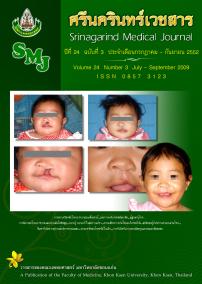ThaiScience
ThaiScience
SRINAGARIND MEDICAL JOURNAL
Volume 35, No. 05, Month SEPTEMBER, Year 2020, Pages 545 - 551
The relationship of lumbar dysfunction and range of motion limitation
Dedchawin Laisirirungrai, Siriwan Yotsungnoen, Worawan Ekabutr, Prasert Sakulsriprasert
Abstract Download PDF
Background and objectives: Low back pain is a health problem affecting daily living in terms of pain, movement and functional limitations. Lumbar dysfunction is commonly found and diagnosed by physical therapists. However, the relationships of lumbar dysfunction and related factors are not yet established. This study therefore aimed to investigate the relationships between the diagnosis of lumbar dysfunction range of motion limitation, and posture. Methods: Study design and setting: The data of low back pain patients were obtained from medical records of Physical Therapy Center, Mahidol University, 252 cases totally, by which 131 cases were diagnosed as lumbar dysfunction and 121 cases diagnosed as other pathologies. The relationships between lumbar dysfunction, range of motion and posture were investigated by chi-square test and the characteristics of subjects were investigated by independent t-test. Results: Age, weight, and body mass index (BMI) were not significantly different between the two groups. Lumbar dysfunction group was correlated with range of motion limitation in all directions especially lumbar flexion and lumbar extension (p = 0.002, 0.006), but lumbar dysfunction group was not correlated with flat back posture.Conclusions: Lumbar dysfunction had a relationship with range of motion limitation in all directions. Therefore, physical therapists should emphasize on physical examination and interventions regarding to range of motion for holistic approach.
Keywords
lumbar dysfunction facet joint syndrome low back painSRINAGARIND MEDICAL JOURNAL
Published by : Faculty of Medicine, Khon Kaen University
Contributions welcome at : http://www.smj.ejnal.com/e-journal/journal/index.php
